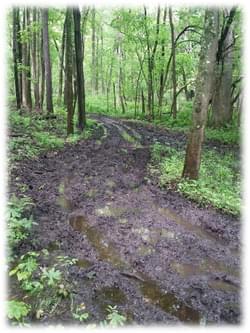




Mud season, Mother Nature’s torment to those who seek solace in nature.
by Lora Goerlich, Owner, Equestrian Trails and Facilities Consultant LLC

Mud season, Mother Nature’s torment to those who seek solace in nature. The mixing of excess water and earth occurs periodically from late fall through late spring in many geographic areas across the United States. As trail enthusiasts and natural resource advocates, we must set high standards for trail use accountability when mud is present. Why? To prevent trail widening which damages surrounding flora and fauna, and to prevent park agencies from creating and enforcing, seasonal, blanket trail closures.
No matter how rugged you are while mountain biking, how tested you are as a hiker or how well trained your horse is, feet, hooves, and wheels almost always find a way around mud - especially on sections where the depth of the quagmire is unknown. Cyclists risk colliding with unseen debris concealed in the dark mud and soiling their clothes with a racing stripe up their backside. Hikers risk ruining shoes or having them sucked off along with tripping, slipping, and falling. Most horses (and riders) will attempt to trudge through the center of a mire but are often unsuccessful. Horses don’t mind getting their feet wet, many have mud in their home paddock after rain, but they know their area, they know there is no risk there. A horse’s instinct is to avoid predators who could be lurking in murky areas, their life depends on it. Add to that, inherent dangers such as soft tissue, joint and bone damage from splaying out on unstable footing and/or tripping over submerged hazards such as exposed roots or downed limbs. A tripping, slipping, or falling mount can also cause traumatic injuries for riders as well. Less dangerous but costly are the loss of horseshoes and hoof boots that are frequently pulled off by sucky mud.
Ultimately, it is your obligation to modify your route, or not go at all if you know the tread is not solid enough for your planned activity. Poor choices have forced some agencies to create temporary, seasonal, and permanent trail closures; in Ohio for example, State Forests began blanket closures in 2020 which affected horse, bike, and ATV trails in all but one State Forest. But… shouldn’t the park fix the issues or re-route problem areas? This article is about being a more responsible and mindful trail user, not about trail maintenance. Make choices that keep trails open, create less maintenance for park staff and protect flora and fauna. Inclusion, no matter the type, is a privilege.
American Hiking Society National Trails Day® Event Host Guide (2023)
posted Apr 16, 2024
This guide will provide you with the following resources and knowledge you need to plan and promote a successful event for National Trails Day®.
League of American Bicyclists National Bike Month Guide (2023)
posted Apr 16, 2024
May is National Bike Month, sponsored by the League of American Bicyclists, and celebrated in communities from coast to coast. This step-by-step guide will help you in creating a successful Bike Month event in your community, workplace, city or state.
Making Transportation Planning Applicable in Tribal Communities Research Study: Final Report
posted Dec 20, 2023
The Federal Highway Administration’s (FHWA) Office of Tribal Transportation (OTT) planning staff have observed two challenges in Tribal transportation planning: (1) that existing planning analysis tools do not always align with Tribal community context and needs and (2) it is not always clear what benefits planning provides to transportation project selection and delivery in Tribal communities.
posted Dec 20, 2023
This report and its appendices constitute a review of law, policy, and procedures, with recommendations for changes based on Tribal consultation and public comments.
766 views • posted 01/25/2023